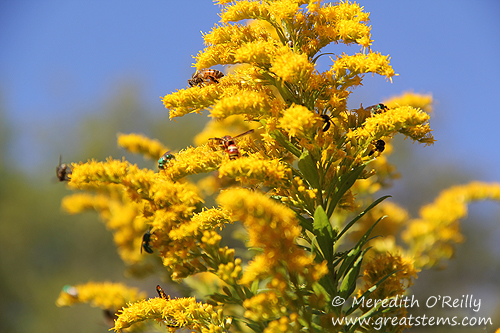
This fall, the Tall Goldenrod in my backyard reminds me once again why it deserves substantial recognition among native plants. Admittedly, it was planted by a bird in a less than convenient spot in my garden, but the rewards it offers pollinators make it a very valuable plant, and I most happily welcome it — even if it would look better against the fence rather than rising out of my shorter perennial butterfly garden like a giant, absurdly-placed monument. Well, I regularly talk about the importance of layers in nature — I shall simply embrace the layers nature brought to my butterfly garden. When I say Goldenrod, by the way, I mean that in a plural sense — I might have started with one, but I now have more, as is the nature of the plant.
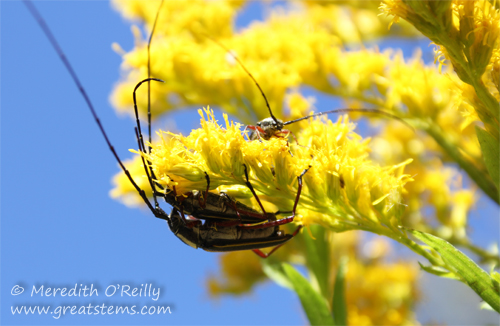
Double-banded Bycid pair mating (Longhorn beetles, Sphaenothecus bivittata)
(with an interested 3rd party above)
The vibrantly-colored Goldenrod is currently a source of high drama in my garden. Nectar and pollen banquets have brought pollinators by the hundreds, and along with lurking predators, insect mating, and numerous larvae moving about, there is a constant flurry of activity going on in and around the bright yellow blooms and tall stems. In terms of habitat, the Goldenrod seems to be representative of an entire ecosystem — nature is hard at work, with all its wonderful interactions between different animal species and with the Goldenrod plants themselves. The role of Goldenrod is vital, providing a nutritious food source for late-season insects and other animals.
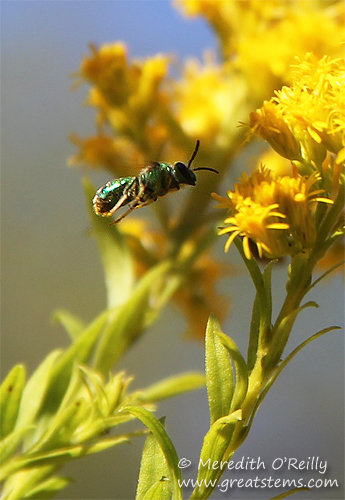
Metallic Green Sweat Bee, Augochloropsis metallica
Goldenrods’ normal habitats are fields and prairies, open woodlands, roadsides, ditches, rocky outcrops, disturbed areas, and waste areas. They often spread by rhizomes, creating colonies of clones, and this somewhat aggressive behavior is one reason some people consider Goldenrods weeds. There are species less prone to spreading, and those are perhaps better choices for smaller gardens. In my garden, my single plant has become a colony of about 12 clones, but what that means is that now I have 12 large, gorgeous bloom clusters to support wildlife. Goldenrods also can spread by seed, of course, which is how I ended up with a Goldenrod in my garden in the first place.
Goldenrods on occasion get another bad rap, unreasonably so. People suffering from hay fever sometimes wrongfully blame Goldenrods, which bloom about the same times as the wind-pollinated Ragweed, the true allergy-causing culprit. Goldenrod is mainly insect-pollinated, its pollen too heavy to be blown very far. Think of all those poor Goldenrods, mistakenly cut down when Ragweed was really to blame!
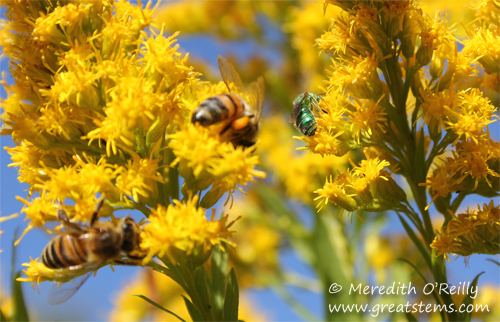 Goldenrods have high wildlife value. They are extremely important to pollinators, offering copious nectar and large, sticky pollen grains. At any point in the warmth of the day, I have hundreds of pollinators visiting the blooms. Standing up close to the flowers, I enjoy the movement of flying insects all around me, bees and wasps completely ignoring me as I turn blooms here and there for a picture or to study a particular insect. They just go about their business, eagerly moving from bloom to bloom to bloom. One cool morning, I even found three honeybees effectively frozen on the Goldenrod flowers, waiting to be warmed by the sun so they could begin to collect pollen again.
Goldenrods have high wildlife value. They are extremely important to pollinators, offering copious nectar and large, sticky pollen grains. At any point in the warmth of the day, I have hundreds of pollinators visiting the blooms. Standing up close to the flowers, I enjoy the movement of flying insects all around me, bees and wasps completely ignoring me as I turn blooms here and there for a picture or to study a particular insect. They just go about their business, eagerly moving from bloom to bloom to bloom. One cool morning, I even found three honeybees effectively frozen on the Goldenrod flowers, waiting to be warmed by the sun so they could begin to collect pollen again.
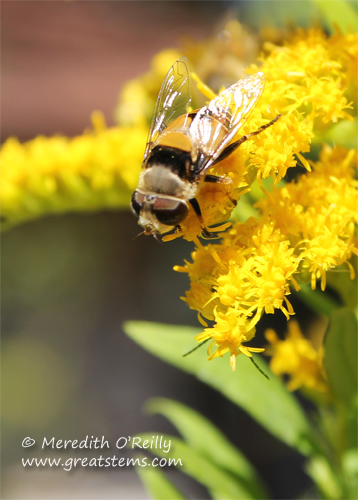
Syrphid fly
I can say confidently that the fragrant and bright Goldenrods have attracted the largest variety of insects of any plant in my wildlife garden. Multiple bee and wasp species, as well as a variety of flies, beetles, butterflies, and true bugs are attracted to the tantalizing blooms. In terms of numbers, the honeybees are the most plentiful, followed closely by numerous sweat bees, all gathering pollen and nectar. There are also many bee mimics, typically flies; their black and yellow coloration potentially help protect them from danger.
White Crab Spider
Aside from the fun I’ve been having watching all the wildlife visiting my Goldenrods, there’s no denying that the bright yellow blooms provide a tremendously attractive pop of color to my garden. They love full sun and can tolerate part shade, and they like it neither too wet nor too dry. Blooms occur from late summer to fall, depending on the species. Often Goldenrods are paired with Fall Aster for a beautiful contrast of color. If there is a concern about potential spreading, transplant regularly and remove spent flowers before they go to seed. Otherwise, let your Goldenrod plants expand naturally if you have the space to allow them to do so — the pollinators will thank you for it!
Allow me to show off some more of the creatures that have been visiting my Goldenrods. Get ready for some yellow!
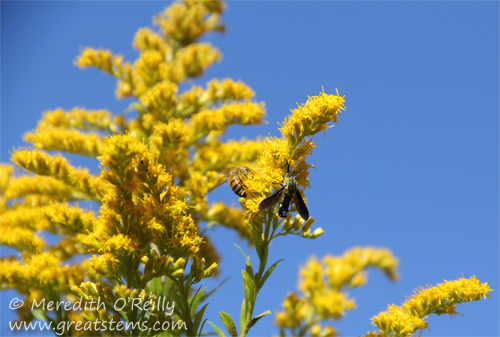
Scaly Bee Fly (Lepidophora lepidocera), with a Honeybee
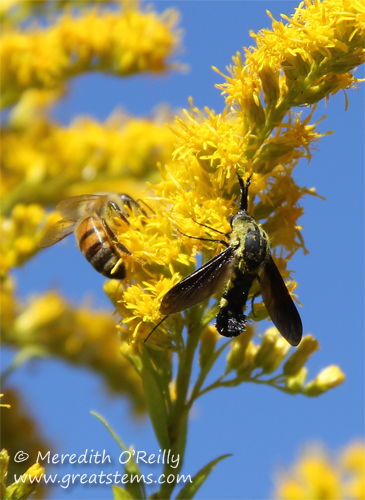
Close-up of the Scaly Bee Fly (Lepidophora lepidocera), with Honeybee.
Note the humped shape of the bee fly.
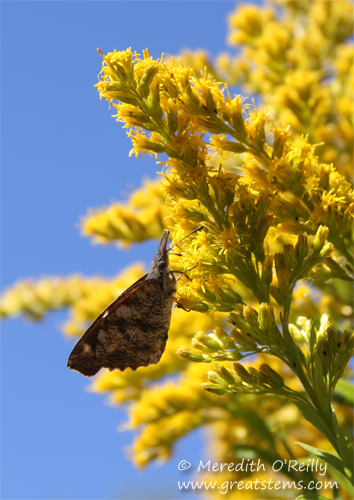
American Snout Butterfly
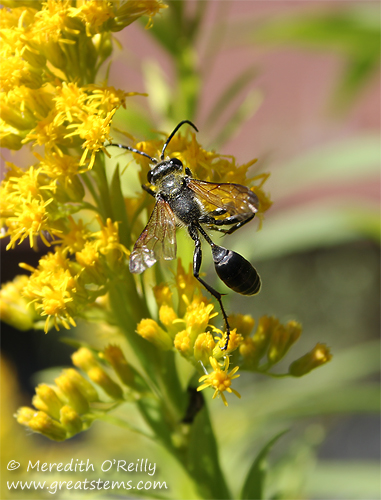
Thread-waisted solitary wasp
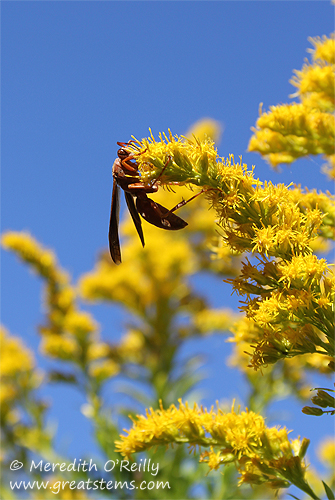
Metallic Green Sweat Bee, Augochloropsis metallica
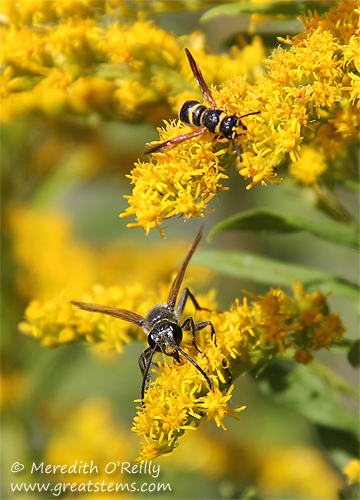
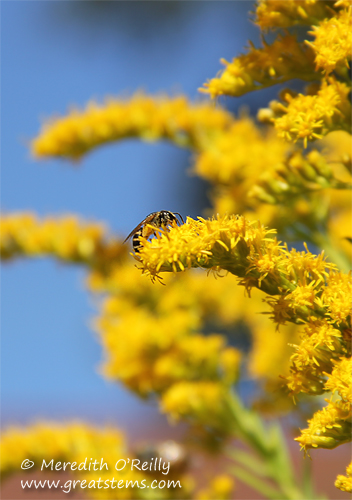
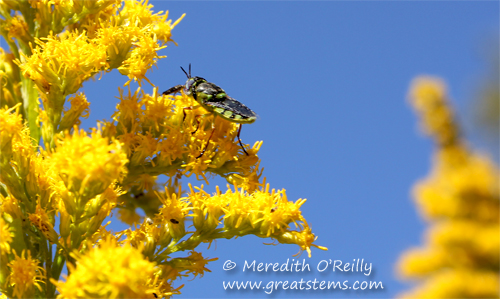
Soldier Fly, Odontomyia cincta
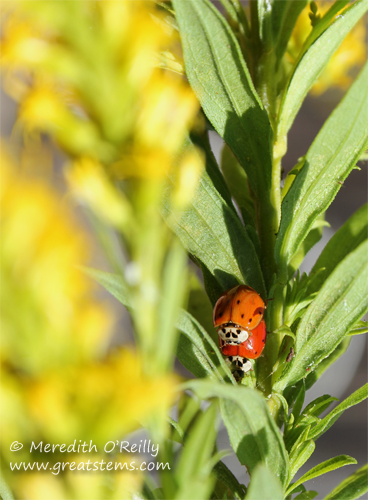 Lady beetles, mating
Lady beetles, mating
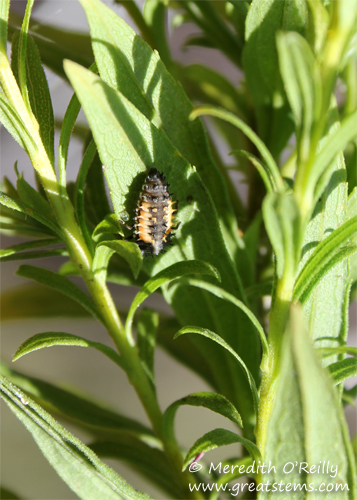
Ladybug larva
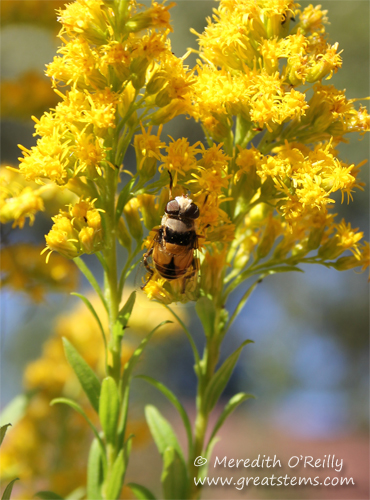
Syrphid fly
Just a sample of many!
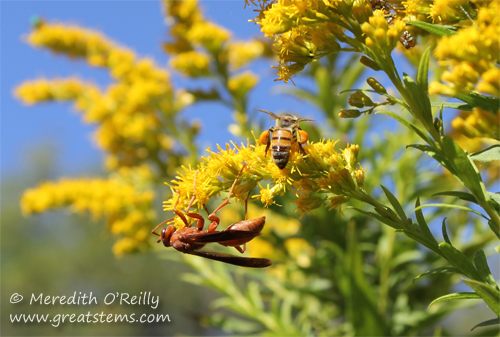
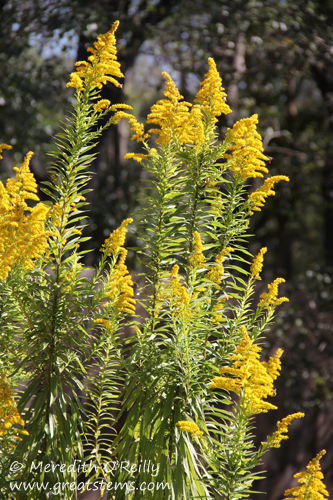
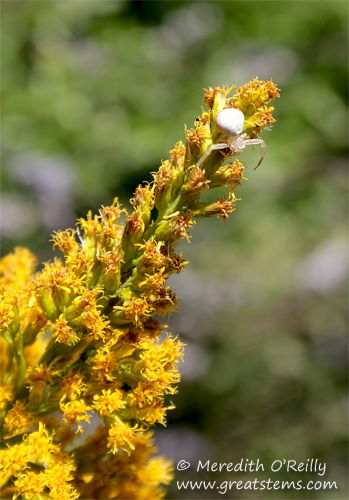
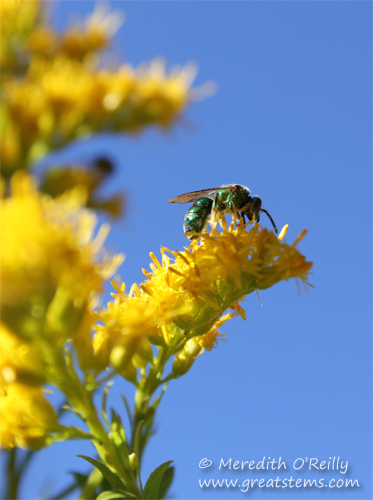
The variety of critters attracted to your goldenrod is amazing – as are your photos. Thanks, as always, for an interesting, beautiful, and educational post.
Thanks, Vicki. I wish it hadn’t been so cool outside when you all visited on Saturday — I would have liked you to see all the pollinators in action!
Fantastic! I’ve wanted to plant Goldenrod for years, but have never gotten around to it. What’s my problem?
Well, Alan, technically I didn’t plant this one either — a bird decided I needed it. Actually, I didn’t mention in the post that I’m also growing Prairie Goldenrod, a shorter variety. This one I did plant, but its blooms have already come and gone, so I didn’t take pictures for the post. I highly recommend you get Goldenrod for the next growing season, though — it’s such fun!
As always, your photos and information are excellent. I don’t have any Goldenrod, but I wish I did. Hmm, where do I have some room???
What a bevy of pollinators in your garden – the photos are amazing! Enjoyed our visit to your garden – lots of cool stuff there!
Thanks, Diana. Glad to have you all visit!
I found a patch of Goldenrod growing next to some Frost weed out where I deer hunt. The bees were on the Goldenrod and the butterflies were all over the Frost weed. Quite a sight.
Remind me to tell you the Malcom Beck, Snout Nose story the next time I see you. It’s a hoot.
I bet that was a fantastic sight to see, Bob. I look forward to hearing the Snout Nose story!
What wonderful pictures! So great to see close-ups of all those intricate insects. Up here in the North goldenrod is all brown now, but it’s providing seeds for birds.
Yep, goldenrod is a gift that keeps on giving!
Meredith, how did we go from small children afraid of bugs, to garden nuts taking pictures of every bug that some into my garden? I used to afraid of bees, now I just take their picture!
We pick up on parents’ fears, I’m sure. But kids are naturally curious — we must let them be so!
I absolutely adore Goldenrod…and, obviously, so do insects! I really must add some to my garden next year…I’ve been missing out!
I’ve reached the “uh-oh, the goldenrod seems a little TOO happy here” stage — time to move some of the plants out of the main garden bed and let them grow in a more free area!
I’ve not seen goldenrod at my place – but what a bounty of insects it draws!
Great plant! This year, I get to change to official management stage, however — the goldenrod is very, VERY happy, if you know what I mean.
Fantastic post. I finally found some of the names of the bugs I was throwing out of my bee collections from this summer. Goldenrod is one of the most important plants for migrating monarch butterflies and is one of the most entertaining plants to have around as you so noted. And making sure to grow it in clumps of about 3 – 5 feet helps the pollinators find it
Up in the Oregon High Desert, I think Rabbitbush must take its place. It actually bloomed both in the spring and late summer and there was usually a few plants in bloom wherever I went in the mid west. And it made a beautiful plant in the winter garden since the seed heads stay on the plant.
Rabbitbush is new to me — I will go look it up!
Beautiful images
Birds and squirrels are among some of the best gardeners, except for when the squirrels dig up my bulbs and replant them in the neighbor’s garden. Then they are very bad. Ha!
Your photos are amazing.
Thanks, Donna! Yes, it’s always a love/hate relationship with those squirrels. I have a squirrel squatter in one of my owl houses — I’m trying to decide whether an eviction might be necessary…